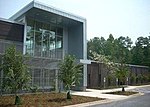William B. Umstead State Park
1937 establishments in North CarolinaCivilian Conservation Corps in North CarolinaHistoric districts on the National Register of Historic Places in North CarolinaIUCN Category VNRHP infobox with nocat ... and 8 more
National Natural Landmarks in North CarolinaNational Register of Historic Places in Raleigh, North CarolinaNature centers in North CarolinaProtected areas established in 1937Protected areas of Wake County, North CarolinaState parks of North CarolinaUse mdy dates from August 2023Works Progress Administration in North Carolina

William B. Umstead State Park is a North Carolina state park in Wake County, North Carolina in the United States. It covers 5,599 acres (22.66 km2) nestled between the expanding cities of Raleigh, Cary, and Durham, North Carolina. It offers hiking, bridle, and bike trails, boat rentals, camping, picnic areas, and educational programs. Part of the East Coast Greenway, a 3,000 mile long system of trails connecting Maine to Florida, runs through the park.
Excerpt from the Wikipedia article William B. Umstead State Park (License: CC BY-SA 3.0, Authors, Images).William B. Umstead State Park
Sycamore Trail, Raleigh
Geographical coordinates (GPS) Address Nearby Places Show on map
Geographical coordinates (GPS)
| Latitude | Longitude |
|---|---|
| N 35.853888888889 ° | E -78.742777777778 ° |
Address
Sycamore Trail
Sycamore Trail
27612 Raleigh
North Carolina, United States
Open on Google Maps






